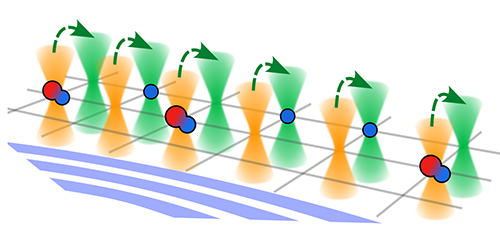Fine Control of Ultracold Polar Molecules
Ultracold atoms are a promising platform for quantum science. Molecules could be even better thanks to properties that atoms lack, such as polarity and the availability of rotational states. Now two independent groups have succeeded in filling one-dimensional arrays of optical traps with ultracold polar molecules assembled from ultracold atoms [1, 2]. The groups also demonstrated that they could set, change, and read out the individual quantum states of the molecules. The feat may enable techniques developed for trapped atoms to be implemented with molecules, making the richer molecular physics available to new quantum applications.
The groups worked with different molecules. Simon Cornish of Durham University in the UK and his collaborators used rubidium-cesium (RbCs) molecules [1]. Kang-Kuen Ni of Harvard University and her collaborators used sodium-cesium (NaCs) molecules [2]. Both groups made and trapped their molecules using arrays of tightly focused laser beams known as optical tweezers.
The teams used two arrays of tweezers, one for each atomic species. After loading cold Cs atoms into one array and cold Rb or Na atoms into the other, they merged the two arrays. They then applied a magnetic field to set up a binding interaction between the atoms—through a so-called Feshbach resonance—and used lasers to drive the formation of molecules. To identify the traps where molecule formation was successful, the teams attempted to remove an atom from each trap: the atom’s removal was only possible if the trap didn’t contain a molecule. By discarding traps with atoms and bringing together those with molecules, they created a more densely filled array.
The Durham and Harvard teams demonstrated that they could manipulate and read out the rotational states of individual molecules using microwave pulses—an attractive feature for applications. What’s more, since RbCs and NaCs are polar molecules, they could be used in schemes that engineer molecular dipole–dipole interactions. Such schemes could open new opportunities in quantum simulation and computing, notably, mimicking systems of interacting spins and creating multilevel qubits.
–Charles Day
Charles Day is a Senior Editor for Physics Magazine.
References
- D. K. Ruttley et al., “Enhanced quantum control of individual ultracold molecules using optical tweezer arrays,” PRX Quantum 5, 020333 (2024).
- L. R. B. Picard et al., “Site-selective preparation and multistate readout of molecules in optical tweezers,” PRX Quantum 5, 020344 (2024).




